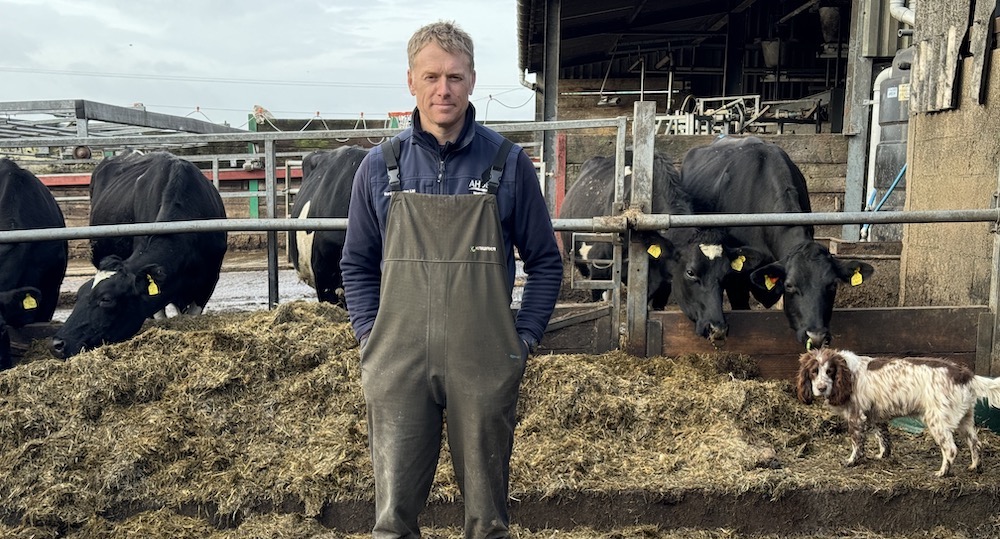We recently caught up with Organic Dairy Farmer Dan Burdett at Cockhaise Farm, near Haywards Heath in West Sussex to shoot a short film to help promote the Farming in Protected Landscapes (FiPL) programme, which is delivered locally by the High Weald National Landscape team. With funding still available for farmers and land managers in the High Weald, I was keen to learn more about how the grants have benefited Dan’s family farm.
By some miracle we managed to pick a sunny and dry day in January to visit Dan. Arriving at Cockhaise farm, Dan greeted us and we walked through the farmyard, where all of his 240 cows and young stock are housed during the winter months. Heading out into one of his herbal ley fields, Dan pointed down to the grass – which looked green and lush. He’d seemed hopeful that it wouldn’t be too long before he could start letting the cows out, even if it was just for an hour or two, to prevent any poaching.
Luckily, Dan and his team have plenty of other jobs to get on with. One big project they are working on at the moment is planting 1420 metres of new hedgerows, designed to connect up the various woodland parcels they have on the farm.
He explained that many of the old hedge lines in the High Weald were grubbed up years ago to create bigger fields. Now, with the help of grant schemes like Farming in Protected Landscapes, farmers and land managers are being paid to reinstate them.
“It’s a no brainer,” said Dan who is passionate about improving the natural environment on his farm.
“These new hedgerows will provide vital corridors for nature, as well as shade and shelter for livestock,” he added.
Hedge Planting
Arriving at the field boundary, Dan introduced us to his small team of helpers, who have been busy planting a new hedgerow. It’s a hive of activity, with two members of the team digging holes with spades, another planting the young tree whips and a fourth team member placing tree guards around each tree to protect them.
Dan explained that in addition to the shade and shelter benefits for the cows, the new hedgerows will also help with nutrient management and water management purposes.

New Wood Chipper
Bidding farewell to the hedgerow team, we headed back to the farmyard, where Dan showed us his shiny new wood chipper, a vital bit of kit which was also part funded by grant money from the Farming in Protected Landscapes programme.
The chipper allows them to make much better use of the brush cuttings on the farm, explained Dan. Every year they clear fell or rotationally coppice areas of their woodland to feed an on-farm biomass boiler. Often, a lot of the brush cuttings were then burnt on site, added Dan, a practice he felt uncomfortable about. Now, 100% of those brushings are chipped and used to create compost.
Dan showed us a pile of wood chip composting in the yard, pointing out signs of fungi activity. It’s a hugely valuable resource, he said, later showing us how they use the composted chippings as an organic mulch on their new hedgerows – recycling all those nutrients back into the farm.
He also has exciting plans to start incorporating dung into the chippings, turning it regularly to create even better compost that can be reapplied to the fields. It’s a small step, he says, but something he wants to explore further in the future.
Process of Applying for the Farming in Protected Landscapes scheme
Dan said applying for the Farming in Protected Landscapes programme was reallystraightforward. After visiting the High Weald National Landscape website, he filled out a simple online enquiry form with a few details about his farm, contact details and a brief description of a project idea. After submitting the enquiry, he got a call from one of the team, who then arranged to come out to visit the farm.
He added the team member can then advise on your idea and even help fill out your application form. Once ready for submission, the form and supporting information goes to a small farmer-led panel* supported by the High Weald team, who meet regularly to assess applications, after which you will hear back with an approval or rejection.
Two of the key objectives for the Farming in Protected Landscapes scheme are benefiting nature and climate; Dan’s projects of hedge planting and recycling nutrients back into the land, with the use of a wood chipper, both ticked the box.
Next steps
If you would like to do a project like this on your land, funding from the Farming in Protected Landscapes programme is still available – visit highweald.org/fipl to learn more and fill out a short online enquiry form. A member of the High Weald National Landscapes team will then get in touch to answer any questions and help you with an application.
More Information
Looking for more inspiration? Checkout some of the other farmers we visited in our Meet the High Weald Farmer series, who have all benefited from the Farming in Protected Landscapes grant scheme.
*Note – Dan is a member of the small farmer-led panel, though had no influence on his own FiPL application.
You can see the video we made below (click link) along with links to the other three farms we visited.
https://www.youtube.com/shorts/zCTYdWRuVK4







